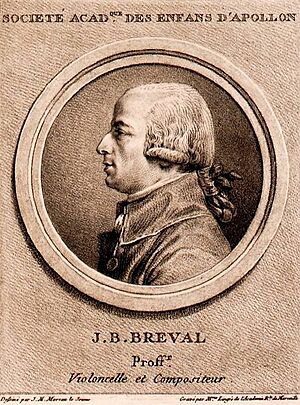Jean-Baptiste Bréval facts for kids
Jean-Baptiste Sebastien Bréval (born November 6, 1753 – died March 18, 1823) was a French cellist and composer. He mostly wrote music for the cello, his own instrument. This included pieces to help students learn and also impressive songs for skilled players.
Contents
Who Was Jean-Baptiste Bréval?
Bréval was born in Paris, France. He learned to play the cello from famous teachers like François Cupis and Martin Berteau. By 1774, he was already a busy cello teacher.
In 1775, he published his first set of works. These were six concertante quartets. A year later, in 1776, he joined a musical group called the «Société Académique des Enfants d'Apollon».
Bréval's Early Career as a Musician
Bréval started his public music career in 1778. He played one of his own sonatas at a famous concert series called Concert Spirituel. He then became a member of their orchestra from 1781 to 1791. After that, he played in the orchestra of the Théâtre Feydeau from 1791 to 1800.
Later, Bréval helped manage the «Concerts de la rue de Cléry». He also joined the Paris Opera orchestra. He stopped playing in the orchestra in 1816. Some records suggest Bréval taught at the Conservatoire, a music school. While this is not fully confirmed, his music was definitely used to teach students there. Bréval passed away in Colligis, France.
What Kind of Music Did Bréval Write?
Bréval wrote many instrumental pieces between 1775 and 1805. His music was known for its lovely tunes and lively rhythms, which Parisians enjoyed.
Bréval's Musical Style
Before 1784, his pieces usually had two or three parts. They often used forms like sonata form or rondo form. Sometimes, he wrote a single-part piece with variations on a tune.
Later in his career, Bréval started to experiment more. For example, his Symphonie concertante for clarinet, horn and bassoon, written around 1795, showed new ideas. His cello concertos, which he played himself, were influenced by Giovanni Battista Viotti. Viotti was known for clear themes mixed with very difficult, showy parts.
Bréval's Most Famous Work
Bréval is best known for his Sonata in C major, Op. 40, No. 1. This piece is a classic for cello students. It is often one of the first full sonatas a cello student learns. You can find the original version from many music publishers. Other versions have also been made for instruments like the viola and bass clarinet.
Bréval's Cello Teaching Book
Perhaps Bréval's most important work was Traité du Violoncelle (1804). This was a book on how to play the cello. It was likely the first organized guide for learning the instrument. However, it did not get good reviews at the time. It also did not include new playing techniques that allowed for more advanced cello playing. Another book, Essai by Jean-Louis Duport, published in 1806, became more popular.
Bréval's Compositions List
Bréval wrote many pieces for different groups of instruments.
Orchestral Music
- Symphonies concertantes (pieces for solo instruments with an orchestra):
- 2 works as Op. 4 (1777), for violins, viola, and cello.
- 2 works as Op. 11 (1783), for violins and cello.
- 1 work as Op. 38 (around 1795), for clarinet, horn, and bassoon.
- 1 for violin and cello, played in Paris in 1787.
- 1 for 2 cellos, played in Paris in 1800.
- Cello Concertos (pieces for a solo cello and orchestra):
- No. 1 in G, Op. 14 (1784)
- No. 2 in D, Op. 17 (1784)
- No. 3 in F, Op. 20 (1785)
- No. 4 in C, Op. 22 (1786)
- No. 5, Op. 24 (1786)
- No. 6 in C, Op. 26 (1786)
Chamber Music
- Quartets (pieces for four instruments):
- 6 quatuors concertants, for 2 violins, viola, and bass, Op. 1 (1775).
- 6 quatuors concertants et dialogués, for violin/flute, violin, viola, and bass, Op. 5 (1778).
- 6 quatuors concertants et dialogués, for 2 violins, viola, and bass, Op. 7 (1781).
- 6 quatuors concertants et dialogués, for 2 violins, viola, and bass, Op. 18 (1785).
- Trios (pieces for three instruments):
- 6 trios concertants et dialogués, for violin, viola, and cello, Op. 3 (1777).
- 6 for (flute, violin, cello) or (2 violins, bass), Op. 8 (1782).
- 6 trio ... concertants et dialogués, for violin, viola, and cello, Op. 27 (around 1786).
- 3 for violin, cello, and doublebass, Op. 39 (around 1795).
- Duets (pieces for two instruments):
- For 2 violins: 6 as Op. 6 (1780), 6 as Op. 10 (1783), 6 as Op. 19 (1785), 6 as Op. 23 (1786), 6 as Op. 32 (around 1791), 6 as Op. 41 (around 1798).
- For 2 cellos: 6 as Op. 2 (1783), 6 duos … pour faciliter l’étude des différentes clefs (to help learn different clefs), Op. 25 (1786).
- For violin and viola: 6 as Op. 15 (1784).
- For 2 flutes: 6 as Op. 16 (1784).
- 6 duos faciles (easy duets), for violin and cello/bassoon, Op. 21 (1785).
- Sonatas (pieces for a solo instrument, often with piano or bass):
- For Cello and Bass: 6 as Op. 12 (1783), 6 as Op. 28 (1787), 6 as Op. 40 (around 1795).
Other Works
- Inès et Léonore, ou La sœur jalouse (an opera), performed in Versailles in 1788.
- Les nocturnes, ou 6 airs variés (6 varied tunes), for violin and cello, Op. 9 (1782).
- Air de Marlborough (a tune with variations), for cello and doublebass or violin and cello, Op. 13 (1783).
- 12 petits airs (12 small tunes), for cello (1799).



